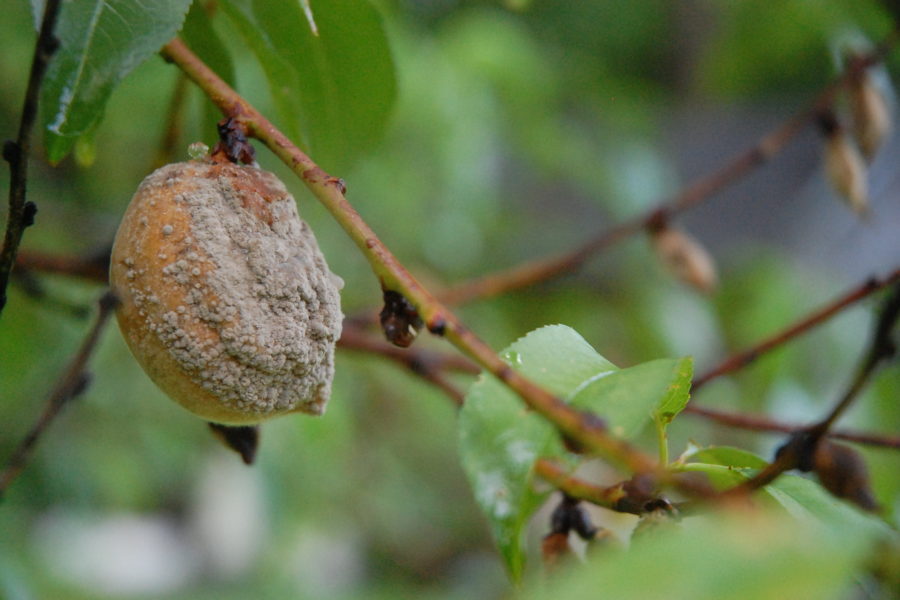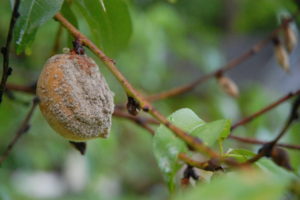I have a tiny orchard on my 10-acre property: two peach trees and a cherry tree, just down slope from the larger portion of forest that makes up the majority of the property. For the past four years I have observed the peaches struggling year after year with Brown Rot, and so I have been researching the management of these trees a bit more intensive, in order that I may someday in the future be able to enjoy a healthy yield of peaches.
I’ve had this lurking motivation for a few years now, and in eager bits of inspiration I’ve been dosing the trees with small splashes of management (pruning, mulching, a few fungicide applications) since we’ve moved in. But nothing serious, nothing consistent, and the brown rot has become rampant, riddling each and every fruit the trees put forth, and I can see that the management will need to be much more intense in order to end this vicious cycle.
My first step this season towards mitigating this infection was an early winter bonfire last week in which I burned a large pile of brush and logs from some arboriculture work earlier this summer. At that steely moment late in the day when both sun and moon glow meet mid sky, I could see the mummified fruits from last summer hanging from their stocks against a snow and dusk covered hill. It was haunting silhouette of failed fruit of this years’ peach crop, a losing battle to an infection of brown rot.
According to the University of Maryland Extension, “The fungus overwinters on infected, withered fruit known as mummies, on fruit stems and in cankers found on small branches,” (https://extension.umd.edu/hgic/topics/diseases-stone-fruit)
With the fire a blaze and burning a mixed fuel of apple branches and ash wood, I took my orchard ladder up the hill with a plastic bucket and fetched a full pail of the rotten little stones, and quickly dumped them into the fire. This mechanical management was a good first step, but I surrendered to the realization that my collection for the burning alter was only one part of a long list of necessities to manage such a disease.
Here is an opportunity to consider an intense pruning dosage as another mechanical management option in infected crowns. It will be important to study each twig and use either thinning or reduction cuts to remove the canker laden twigs. This will be particularly helpful in an orchard like my small plot that has not been managed by consistent pruning cycles and an integrated pest management scheme (which in itself can lend as factor contributing to infection). Hopefully, a good number of scaffold limbs can be maintained with a healthy population of twigs and buds. Pruning provides other opportunities to manage the disease in other aspects well. In addition to removing the twig cankers, good pruning can structure the crown better to provide ample space between fruit bearing stems. Because, according to Purdue University Facts for Fancy Fruit, “young fruit is normally resistant to brown rot but can become infected through wounds…and that any type of injury to ripening fruit (insect, hail, twig rubs, picking injury) will provide an entry point for the brown rot fungus” (https://fff.hort.purdue.edu/article/brown-rot/). A crowded crown with crossing limbs will be very likely to cause mechanical damage to its own young fruit, especially in hot, humid conditions before a summer thunderstorm with high winds and possibly even hail. By organizing the crown, the mantra is something like this, ‘preserve healthy stems and twigs; and leave good space between the sprigs’. In my own mind, it works.
Also, I want to consider the reaction to the pruning as an investment opportunity as well. Healthy trees actively grow, and therefore pruning becomes a long term commitment, especially intensive pruning required for orcharding. In certain cases of a heavily infected limb where bigger pruning cuts may see more growth response from the activation of dormant buds around that cut, those new growth sprouts can be structured over time into fruit bearing limbs for the future. But there will be a cost to such a pruning cut as well, making it susceptible to other types of infection as well. With this consideration, nothing beats the invaluable investment of structured pruning in stone fruits from a young age.
Winter is definitely not the proper time to prune stone fruits because of the risk of infection of cytospora canker. The spores colonize live wounds of the peach tree, and battling brown rot and canker in the same tree can be extremely challenging.
According to an article by Kari A. Peter, PH.D., “the fungi causing the disease overwinter in cankers and dead twigs. Small black fruiting bodies appear on the smooth bark covering diseased areas of dead wood and begin to produce spores once temperatures are above freezing. Wet weather washes the spores from the fruiting structures. Because infections do not usually occur when trees are growing vigorously, most occur during fall, early spring, and winter. Healthy bark or buds are not attacked by the fungus. Cold-injured buds or wood and pruning cuts are the most important sites of infection. The fungus can also penetrate brown rot cankers, Oriental fruit moth damage, sunscale wounds, hail injury, leaf scars, and mechanical wounds. Once established in the wood, the fungus forms a canker by invading the surrounding healthy tissue,” https://extension.psu.edu/stone-fruit-disease-cytospora-canker
A good bonfire for this past season’s peach mummies, and pruning after the peach flowers in the spring to remove twig cankers is a good initial plan in the management of brown rot on peach trees. It is an opportunity to become more intimate with a small orchard as well. These initial steps will minimize the spores that will overwinter in the soil and in the twig, setting the spring stage to continue a more intensive IPM program, and possibly exploring the idea of fungicide applications as well. The coming spring will also be a good opportunity to structure the tree crown, as well as increase airflow and light penetration to battle against the humid conditions favorable to canker and brown rot. It will be a time to continue monitoring for active twig cankers as well, in order that the trees be kept as clean from infection as possible.
These are just a few initial thoughts stemming from the observation of brown rot in peach trees.






Leave a Reply
Your email is safe with us.